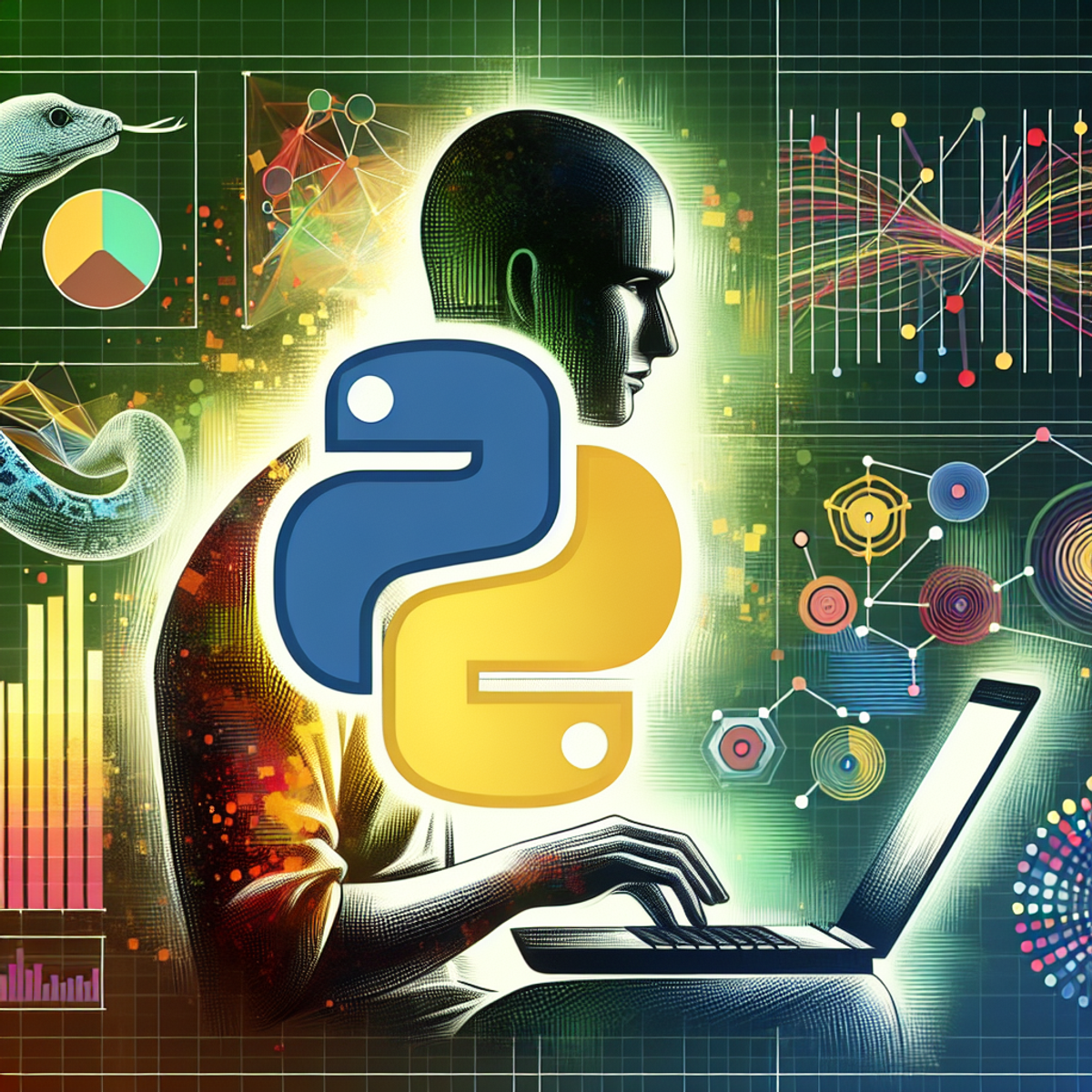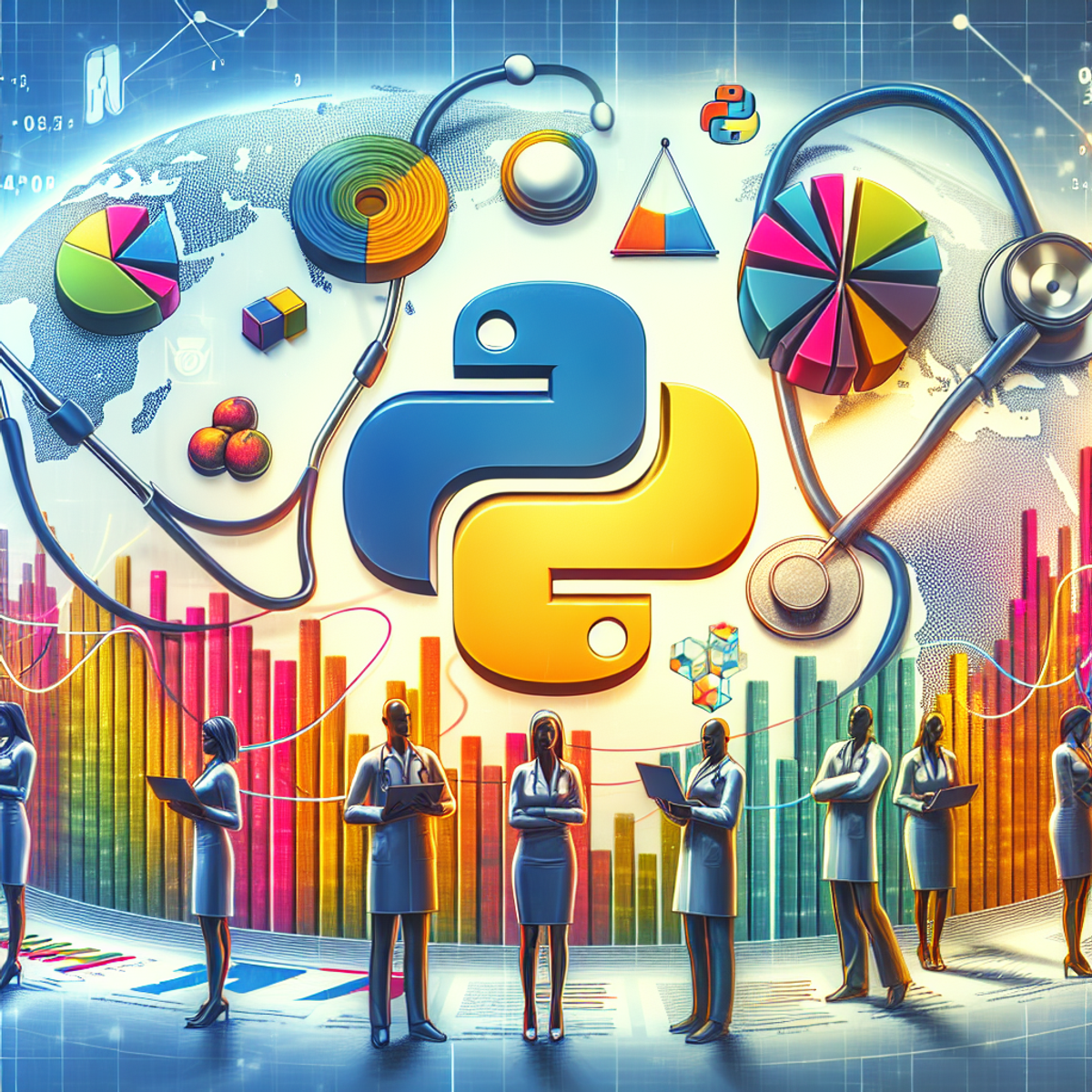Python for Public Health Analytics

Python for Public Health Analytics
Introduction
Public health analytics plays a crucial role in improving population health outcomes by leveraging data to identify trends, assess risks, and inform evidence-based interventions. The increasing availability of diverse data sources in public health, including electronic health records, social determinants of health, and environmental factors, underscores the need for robust analysis tools. Python has emerged as a powerful and versatile tool for public health analytics due to its rich ecosystem of libraries tailored for data manipulation, analysis, and visualization.
Python's flexibility and specialized libraries make it an ideal choice for handling the complexities of public health datasets, which often involve large-scale or unstructured data.
By learning Python for public health analytics, you gain the ability to:
- Extract meaningful insights from complex datasets
- Perform advanced statistical analyses
- Create compelling visualizations to effectively communicate findings to stakeholders
Whether you are a public health professional aiming to enhance decision-making processes or a data scientist interested in applying your skills to address critical healthcare challenges, mastering Python can significantly elevate your capabilities in the realm of public health analytics.
Understanding Public Health Analytics
Public health analytics is a multidisciplinary field that combines data science and epidemiology to improve population health outcomes. It involves the collection, analysis, and interpretation of data to identify patterns, trends, and risk factors related to public health issues. By leveraging advanced analytical techniques, public health professionals can gain valuable insights for decision-making and intervention strategies.
Activities in Public Health Analytics
Public health analytics encompasses a wide range of activities, including:
- Data Collection: Gathering relevant data from various sources such as healthcare systems, surveys, registries, and social media platforms.
- Data Management: Storing, cleaning, and organizing the collected data to ensure accuracy and consistency.
- Data Analysis: Applying statistical methods and machine learning algorithms to identify patterns, correlations, and associations within the data.
- Data Visualization: Representing the analyzed data through charts, graphs, maps, and other visual tools to facilitate understanding and communication.
- Interpretation: Drawing meaningful insights from the analyzed data to inform decision-making processes in public health.
Importance of Public Health Analytics
Public health analytics plays a crucial role in addressing complex public health challenges by providing evidence-based solutions. It enables public health professionals to:
- Identify emerging health trends: By analyzing large-scale datasets, public health analysts can detect patterns that indicate the emergence of new diseases or changing disease patterns in specific populations.
- Evaluate intervention effectiveness: Through rigorous analysis of intervention programs and policies, public health professionals can assess their impact on population health outcomes and make informed decisions regarding resource allocation.
- Allocate resources efficiently: By analyzing population-level data on disease prevalence, risk factors, and healthcare utilization patterns, public health professionals can optimize resource allocation to target high-risk populations or areas with limited resources.
Skills Required for Public Health Analytics
To successfully navigate the field of public health analytics, it is essential for professionals to have a solid understanding of data science principles as well as domain-specific knowledge in epidemiology and public health. Python, with its extensive library ecosystem and user-friendly syntax, is a powerful tool that can facilitate data analysis and exploration in public health.
In the next section, we will explore the history and advantages of Python in the context of data-driven fields and understand why it is particularly relevant for public health analytics.
Role of Analytics in Public Health Decision-Making
Public health analytics plays a crucial role in informing evidence-based interventions, aiding decision-making processes, and improving population health outcomes. By leveraging various analytics techniques, public health professionals can effectively identify emerging health trends, evaluate intervention effectiveness, and allocate resources efficiently.
Key Components of Public Health Analytics
Here are some key components of the public health analytics process that highlight its significance in decision-making:
- Identifying Emerging Health Trends: Analytics allows public health professionals to analyze large volumes of data from diverse sources such as electronic health records, surveys, and social media to identify patterns and trends. For example, by analyzing social media data, researchers can detect early signals of disease outbreaks or monitor public sentiment towards vaccination campaigns.
- Evaluating Intervention Effectiveness: Through rigorous analysis, analytics helps determine the impact of different interventions on health outcomes. For instance, public health researchers can conduct retrospective studies using observational data to assess the effectiveness of a specific public health program or policy.
- Allocating Resources Efficiently: Public health organizations often face resource constraints and need to allocate their limited resources effectively. Analytics provides insights into the most effective strategies for resource allocation based on data-driven models and simulations. This ensures that interventions are targeted to populations at higher risk or with specific needs.
- Supporting Evidence-Based Decision-Making: By integrating data from various sources and applying advanced statistical methods, analytics enables evidence-based decision-making in public health. It helps policymakers and practitioners make informed choices about interventions, policies, and resource allocation to maximize population health impact.
In summary, public health analytics empowers decision-makers by providing them with actionable insights derived from data analysis. It enables them to identify emerging trends, evaluate intervention effectiveness, and allocate resources efficiently to improve population health outcomes.
Python for Data Analysis in Public Health
The Python programming language has gained significant popularity in the field of public health analytics due to its numerous advantages and capabilities. Let's explore the brief history of Python and understand why it is well-suited for data analysis in the context of public health.
Brief History and Advantages of Python
Python was created by Guido van Rossum and first released in 1991. It was designed to be a simple, readable, and versatile language that emphasizes code readability and ease of use. Over the years, Python has evolved into a powerful programming language with a strong community and extensive library ecosystem.
There are several advantages that make Python an excellent choice for data analysis in public health:
- Readability: Python code is easy to read and understand, making it accessible to both beginners and experienced programmers. Its clear syntax and use of indentation instead of braces contribute to its readability.
- Extensive Library Ecosystem: Python provides a vast collection of libraries specifically tailored for data analysis. These libraries offer a wide range of tools and functionalities that enable efficient manipulation, analysis, visualization, and modeling of public health datasets.
- Strong Community Support: Python has a large and active community of developers who contribute to its growth and provide support through forums, online communities, and extensive documentation. This support network ensures that users can easily find answers to their questions and access helpful resources.
Python's flexibility and specialized libraries make it particularly relevant for handling diverse public health datasets, which can often be large-scale or unstructured in nature. Let's explore some of the essential Python libraries used in public health data analysis.
Essential Python Libraries for Public Health Data Analysis
To effectively analyze public health data using Python, there are several essential libraries at your disposal. These libraries provide powerful tools for data manipulation, analysis, visualization, and statistical modeling. Some key libraries include:
Pandas
Pandas is a widely used library that provides data structures, such as DataFrame, which allow for efficient manipulation and analysis of structured data. It offers a plethora of built-in functions and methods that simplify common data operations, making it an invaluable tool for public health analytics.
With Pandas, you can perform various operations on public health datasets, such as filtering and sorting data, handling missing values, merging datasets, and aggregating data to extract meaningful insights.
NumPy
NumPy is a fundamental library for scientific computing in Python. It provides support for efficient numerical computations and array operations, which are essential for tasks like statistical analysis and mathematical modeling in the context of public health.
With NumPy, you can perform advanced mathematical operations, generate random numbers, calculate summary statistics, and manipulate multi-dimensional arrays efficiently.
Matplotlib
Data visualization plays a crucial role in effectively communicating findings to stakeholders in public health. Matplotlib is a versatile library that enables the creation of static, interactive, and geospatial plots.
Whether you need to create line charts, scatter plots, bar graphs, histograms or heatmaps, Matplotlib provides a wide range of customizable options to visualize your public health data effectively.
Seaborn
Seaborn is built on top of Matplotlib and offers higher-level statistical visualizations that are particularly useful for exploratory data analysis (EDA) in public health. It provides easy-to-use functions for creating informative and visually appealing statistical graphics.
Seaborn's capabilities include creating scatter plots with regression lines, visualizing distributions with kernel density estimates (KDE), creating box plots with categorical variables, and much more. These visualizations help uncover patterns, relationships, and outliers in public health datasets.
These essential Python libraries provide a solid foundation for performing data analysis in the field of public health.
Relevance of Python for Public Health Analytics
The Python programming language is widely recognized for its versatility and extensive library ecosystem, making it a preferred language for data analysis tasks in various industries, including public health. Python offers several advantages that make it particularly relevant for public health analytics:
1. Versatility
Python is a general-purpose programming language that can be used for a wide range of tasks, from data manipulation and analysis to web scraping and machine learning. Its flexibility allows public health professionals to tackle diverse challenges and adapt their analyses to different datasets and research questions.
2. Specialized Libraries
Python provides numerous specialized libraries that are specifically designed for data analysis in public health. These libraries offer a wealth of pre-built functions and tools, simplifying complex tasks and reducing the need for manual coding. Examples include Pandas for data manipulation, NumPy for numerical computations, Matplotlib for data visualization, and Scikit-learn for machine learning.
3. Handling Diverse Datasets
Public health datasets can be large-scale or unstructured in nature, requiring robust tools to handle them effectively. Python's libraries enable efficient processing of these datasets, offering functions for data cleaning, transformation, merging, and aggregation. With Python, public health professionals can easily handle complex data structures and perform advanced analyses.
4. Integration with Other Tools
Python seamlessly integrates with other popular tools and technologies used in the field of public health analytics. For example, Python can be used alongside SQL databases to query and extract relevant data. It also integrates well with visualization frameworks like Plotly and interactive dashboard tools like Dash, allowing public health professionals to create compelling visualizations and share insights with stakeholders.
By leveraging the versatility of the Python programming language and its specialized libraries, public health professionals can effectively analyze diverse datasets, uncover meaningful insights, and make informed decisions to improve population health outcomes.
Essential Python Libraries for Public Health Data Analysis
Pandas
Pandas is a powerful Python library that provides extensive data manipulation and analysis tools through its DataFrame structure. It is widely used in public health analytics for handling diverse datasets and performing various operations to extract valuable insights.
Key Features of Pandas:
- DataFrame Structure: Pandas offers a versatile DataFrame structure that allows users to efficiently work with structured data, such as public health datasets containing information about demographics, diseases, and interventions.
- Data Manipulation: With Pandas, you can easily filter, sort, and reshape public health data to suit specific analytical needs. For instance, you can merge multiple datasets, handle missing values, and transform variables to facilitate in-depth analysis.
- Descriptive Statistics: Pandas provides convenient functions for calculating descriptive statistics, such as mean, median, standard deviation, and percentiles from public health datasets. These statistics are essential for understanding the distribution and characteristics of health-related variables.
Example Operations with Pandas:
- Data Aggregation: You can use Pandas to aggregate public health data at different levels (e.g., regional, national) to calculate summary statistics or derive new variables for further analysis.
- Time Series Analysis: Pandas enables the manipulation of temporal data, making it suitable for analyzing trends in public health indicators over time, such as disease incidence rates or vaccination coverage.
- Merging Datasets: Public health datasets often come from multiple sources. Using Pandas, you can merge these datasets based on common identifiers to create a unified dataset for comprehensive analysis.
- Handling Missing Values: Public health data may contain missing values due to various reasons. Pandas offers tools for imputing missing values or excluding incomplete records without losing valuable information.
Pandas plays a crucial role in enabling public health professionals to effectively manage and analyze complex datasets, ultimately contributing to evidence-based decision-making and interventions in the field of public health analytics.
NumPy
NumPy is one of the fundamental libraries for numerical computing in Python. It stands for Numerical Python and provides a powerful array object and a collection of functions for working with large, multi-dimensional arrays and matrices. Here are the key points about NumPy in the context of public health analytics:
1. Efficient numerical computations
NumPy is designed to efficiently perform numerical computations, making it ideal for tasks like statistical analysis and mathematical modeling in public health. The underlying C implementation of NumPy arrays allows for fast execution of operations, even on large datasets.
2. Multi-dimensional arrays
NumPy introduces the ndarray object, which represents multi-dimensional arrays. These arrays can be of any dimensionality and contain elements of the same data type. In public health analytics, this means you can work with data that has multiple dimensions, such as time series data or spatial data.
3. Element-wise operations
NumPy provides a wide range of mathematical functions that operate element-wise on arrays. This means you can perform operations on each element of an array without needing to write explicit loops. For example, you can calculate the mean or standard deviation of an array using simple NumPy functions.
4. Broadcasting
Broadcasting is a powerful feature in NumPy that allows for arithmetic operations between arrays with different shapes. This eliminates the need for explicit looping or reshaping of arrays, making your code more concise and efficient. In public health analytics, broadcasting can be particularly useful when dealing with data that has missing values or irregular shapes.
5. Integration with Pandas
NumPy integrates seamlessly with Pandas, another essential library for data manipulation in Python. Pandas uses NumPy arrays as the underlying data structure for its DataFrame object, providing efficient computation capabilities along with flexible indexing and slicing options.
Here's an example to illustrate the role of NumPy in public health analytics:
Suppose you have a dataset containing the daily number of COVID-19 cases in different regions. You can use NumPy to perform various computations on this dataset:
- Calculate the mean, median, and standard deviation of the daily case counts across all regions.
- Compute the maximum and minimum values of cases for each day.
- Perform mathematical operations like addition, subtraction, multiplication, or division on the case counts to analyze trends or calculate growth rates.
By using NumPy's efficient array operations, you can easily perform these calculations and gain insights from the data in a concise and computationally efficient manner.
NumPy plays a crucial role in public health analytics by providing:
- Efficient numerical computations
- Handling multi-dimensional arrays
- Enabling element-wise operations
- Supporting broadcasting
- Integrating seamlessly with Pandas
Its powerful capabilities make it an essential library for analyzing and manipulating data in the field of public health.
Matplotlib
Python libraries play a crucial role in public health analytics projects, providing powerful tools for data analysis and visualization. One such library is Matplotlib, which is widely used for creating static, interactive, and geospatial plots. In this section, we will highlight the importance of data visualization in communicating findings to stakeholders and showcase the versatility of Matplotlib in public health analytics.
Importance of Data Visualization in Public Health Analytics
Data visualization is an essential aspect of public health analytics as it helps in effectively communicating complex information to various stakeholders. Visualizations enable public health professionals to identify patterns, trends, and outliers in the data, facilitating informed decision-making. Here are some key reasons why data visualization is crucial in public health analytics:
- Enhancing Data Understanding: Visualizations provide a comprehensive overview of the data, allowing analysts to explore and understand the underlying patterns and relationships more easily.
- Identifying Outliers and Anomalies: By visualizing the data, public health professionals can quickly identify outliers or anomalies that may require further investigation.
- Presenting Findings Clearly: Visualizations help present analytical findings in a clear and concise manner, making it easier for stakeholders to interpret and comprehend complex information.
- Engaging Stakeholders: Visualizations make it easier to engage stakeholders by presenting data in an intuitive and interactive format that encourages exploration and understanding.
To learn more about different techniques used in data visualization, you can refer to this informative article.
Versatility of Matplotlib in Public Health Analytics
Matplotlib is a widely-used Python library for creating high-quality visualizations. It provides a flexible and powerful interface for generating a wide range of plots, including line plots, scatter plots, bar plots, histograms, heatmaps, and more. Here are some key features and functionalities of Matplotlib that make it invaluable in public health analytics:
- Customizability: Matplotlib allows users to customize every aspect of their plots, including colors, labels, axes, legends, and more. This flexibility ensures that visualizations align with the specific requirements and preferences of public health analysts.
- Publication-Quality Plots: Matplotlib produces plots of exceptional quality suitable for publication or presentation. The library provides fine-grained control over plot aesthetics, ensuring that visualizations are visually appealing and professional-looking.
- Integration with Pandas: Matplotlib seamlessly integrates with Pandas, another popular Python library for data analysis. This integration allows analysts to directly plot data stored in Pandas DataFrames, making it effortless to create visualizations from public health datasets.
- Geospatial Visualization: Matplotlib also has support for geospatial visualization, enabling analysts to create maps and visualize spatial patterns in public health data. This functionality is particularly useful when studying the distribution of diseases or assessing the impact of interventions across different regions.
Examples of Matplotlib in Public Health Analytics
Let's consider a practical example to demonstrate how Matplotlib can be used in public health analytics. Suppose we have a dataset containing information about the number of COVID-19 cases reported in different states over time. We can use
Seaborn
Seaborn is an important Python library commonly used in public health analytics projects. It builds upon Matplotlib with higher-level statistical visualizations that are particularly useful for exploratory data analysis in public health.
Applying Python in Public Health Analytics Projects
Python is a versatile programming language that can be used for a wide range of applications, including public health analytics. In this guide, we will explore how Python can be applied to various stages of a public health analytics project, from data collection to visualization and analysis. By following this step-by-step guide, you will learn how to use Python effectively in your own public health projects.
1. Data Collection and Preprocessing with Python
The first step in any data analysis project is to gather the necessary data. In the context of public health, this may involve collecting information from online sources such as government databases or healthcare websites. Python provides powerful tools for web scraping, which is the process of extracting data from websites.
In this stage, we will cover:
- Using Python for web scraping to gather relevant public health data from online sources.
- Handling missing values by employing Python libraries like Pandas to clean and preprocess the data effectively.
2. Exploratory Data Analysis and Visualization Techniques
Once we have collected and preprocessed our data, the next step is to explore it using descriptive statistics and visualizations. This stage allows us to understand the underlying patterns and trends in the data before moving on to more advanced analysis techniques.
In this stage, we will cover:
- Utilizing Python libraries like Pandas, Matplotlib, and Seaborn to conduct exploratory data analysis.
- Visualizing the data using these libraries to gain insights into public health trends and patterns.
3. Statistical Analysis, Hypothesis Testing, and Machine Learning
After gaining a basic understanding of our data through exploratory analysis, we can now dive deeper into statistical analysis and hypothesis testing. These techniques allow us to make inferences about the population based on our sample data and test various hypotheses.
In this stage, we will cover:
- Employing Scipy, Statsmodels, and Scikit-learn to perform statistical analysis on public health datasets.
- Using machine learning algorithms to extract meaningful insights from the data.
4. Building Interactive Dashboards
The final stage of our public health analytics project is to communicate our findings effectively. One way to do this is by creating interactive dashboards that allow users to explore the data on their own. Python offers several libraries, such as Plotly and Dash, that make it easy to build interactive visualizations.
In this stage, we will cover:
- Leveraging Plotly and Dash to create interactive dashboards that monitor key health indicators over time.
By following this guide, you can harness the power of Python for comprehensive analysis of public health data, enabling you to make informed decisions and recommendations for improving population health outcomes.
Case Studies: Real-World Applications of Python in Public Health
Analyzing Disease Outbreak Patterns with Python
In the field of public health, analyzing disease outbreak patterns is crucial for effective intervention strategies and resource allocation. Python has been widely used to analyze the spread of contagious diseases within populations, providing valuable insights for public health professionals.
Case Study: Measles Outbreak Analysis in a Densely Populated City
One notable case study where Python was utilized is the analysis of a measles outbreak in a densely populated city. By leveraging Python's data analysis and visualization capabilities, researchers were able to identify high-risk areas and devise targeted vaccination campaigns.
The analysis involved the following steps:
- Data Collection and Preprocessing:Collecting data on reported measles cases, including information on location, date of diagnosis, and demographic factors.
- Cleaning and preprocessing the data to remove any inconsistencies or missing values.
- Exploratory Data Analysis (EDA):Using Pandas, researchers performed EDA to gain insights into the temporal and spatial patterns of the outbreak.
- They visualized the data using Matplotlib and Seaborn to create visual representations of the disease spread over time.
- Heatmaps and choropleth maps were generated to identify clusters of cases and visualize areas with higher transmission rates.
- Statistical Analysis:Researchers utilized statistical techniques in Python to analyze various aspects of the outbreak.
- They calculated key metrics such as incidence rates, attack rates, and reproductive numbers to understand the severity of the epidemic.
- Hypothesis testing was conducted to determine if there were significant differences in infection rates among different age groups or geographical locations.
- Machine Learning:To predict future outbreak patterns, machine learning algorithms were employed.
- Scikit-learn was used to build models that could forecast the spread of measles based on historical data and other relevant factors such as population density or vaccination coverage.
By applying Python in this case study, public health officials were able to gain a comprehensive understanding of the outbreak dynamics and make data-driven decisions. The insights obtained from the analysis helped them allocate resources effectively, prioritize vaccination efforts, and implement targeted interventions in high-risk areas.
"Python's versatility, combined with its robust libraries for data analysis and visualization, makes it an invaluable tool for public health professionals seeking to leverage data-driven approaches in their work."
Predictive Modeling for Optimizing Public Health Interventions
In this section, we will explore real-life examples of how Python has been used to tackle important public health issues, including disease outbreaks and healthcare resource allocation.
Case Studies: Using Python for Public Health Analytics
1. Disease Outbreak Investigation
One area where Python has proven invaluable is in the analysis of disease outbreaks. By leveraging its data manipulation and visualization capabilities, public health professionals have been able to:
- Identify patterns and trends in the spread of infectious diseases
- Monitor the effectiveness of control measures
- Predict future outbreaks based on historical data
2. Resource Allocation for Mental Health Services
Another critical aspect of public health is ensuring that resources are allocated efficiently, especially when it comes to mental health services. By using predictive modeling techniques in Python, policymakers can:
- Identify high-risk populations that require targeted interventions
- Optimize the distribution of limited resources such as psychiatric beds or counseling services
- Evaluate the long-term impact of different intervention strategies on public health outcomes
The Power of Predictive Modeling
Predictive modeling refers to the process of using historical data to make informed predictions about future events or outcomes. In the context of public health, this can be incredibly useful for:
- Early Detection: Identifying potential disease outbreaks before they become widespread, allowing for timely intervention and containment efforts.
- Risk Assessment: Assessing an individual's likelihood of developing a certain condition (e.g., diabetes, heart disease) based on their demographic characteristics, lifestyle factors, and genetic predisposition.
- Targeted Intervention: Tailoring prevention and treatment strategies to specific subgroups within the population who are at higher risk or have unique needs.
- Resource Planning: Allocating limited resources (e.g., vaccines, hospital beds) in a way that maximizes their impact and minimizes disparities.
By leveraging the power of advanced machine learning algorithms implemented in Python, public health practitioners can gain valuable insights from complex datasets and make data-driven decisions to improve population health outcomes.
Challenges and Future Directions
Potential Challenges in Utilizing Python for Public Health Analytics
Data Privacy Concerns: As public health datasets often contain sensitive information, ensuring data privacy and security becomes a paramount concern when using Python for analytics. It requires robust measures to protect individual privacy while extracting valuable insights. This is especially crucial in light of the National Strategy to Advance Privacy-Preserving Data Sharing and Analytics, which emphasizes the need for responsible data handling.
Interdisciplinary Collaboration: Effective utilization of Python in public health analytics necessitates collaboration between data scientists and domain experts. Bridging the gap between these two disciplines is crucial for interpreting analysis results accurately and deriving actionable conclusions. A recent LinkedIn post by a renowned expert emphasizes the importance of effective collaboration for successful data-driven decision-making.
Outlook on Future Developments in the Field
Emergence of Novel Data Sources: The field of public health analytics is witnessing an influx of novel data sources, including information from wearable devices and social media platforms. Integrating and analyzing these diverse datasets using Python presents exciting opportunities for gaining comprehensive insights into population health trends.
Ethical Implications of Algorithmic Decision-Making: With the increasing use of algorithms in public health interventions, ethical considerations surrounding fairness, accountability, and transparency have gained prominence. Future directions involve addressing these ethical implications to ensure responsible and equitable decision-making processes.
Conclusion
Python is a powerful tool for public health professionals, offering a wide range of data science techniques for population analysis. By embracing Python and staying updated with the latest advancements in the field, you can enhance your skills and make a greater impact in your career.
Here are some key takeaways:
- Python's Potential: Python has the potential to revolutionize public health analytics and decision-making processes. Its flexibility, scalability, and extensive libraries make it an ideal choice for handling large datasets and performing complex analyses.
- Continuous Learning: In the rapidly evolving field of data science, it's crucial to keep learning and adapting to emerging tools and methodologies. By investing time in expanding your knowledge and skill set, you can stay ahead of the curve and deliver more effective solutions.
- Community Engagement: Actively engaging in the Python and public health communities can provide valuable opportunities to learn from others, share knowledge, and collaborate on projects. Whether it's participating in online forums, attending conferences, or joining local meetups, building connections with like-minded professionals can enrich your learning journey.
Remember, Python is just a tool. It's how we use it that truly matters. By combining technical expertise with domain knowledge and a deep understanding of public health issues, you can leverage Python to drive meaningful change and improve population health outcomes.
So go ahead, explore the world of Python in public health, and unlock new possibilities for your career!
FAQs (Frequently Asked Questions)
What is Public Health Analytics?
Public health analytics can be defined as the multidisciplinary field that combines data science and epidemiology to analyze and interpret public health data. It plays a crucial role in informing evidence-based interventions and improving population health outcomes.
What are the advantages of Python for data analysis in public health?
Python offers advantages such as readability, an extensive library ecosystem, and strong community support, making it a preferred language for data analysis tasks in various industries, including public health. Its versatility and specialized libraries also make it well-suited for handling diverse public health datasets.
How does Pandas contribute to public health data analysis?
Pandas provides powerful data manipulation and analysis tools through its DataFrame structure. It enables public health professionals to perform typical operations on public health datasets, such as cleaning, transforming, and analyzing the data effectively.
What is the role of NumPy in public health analytics?
NumPy plays a crucial role in efficient numerical computations for tasks like statistical analysis and mathematical modeling in the context of public health. It provides essential support for handling large-scale numerical data, which is often encountered in public health datasets.
How can Python be applied in end-to-end analysis of public health data?
Python can be used for various stages of public health data analysis, including data collection and preprocessing, exploratory data analysis and visualization techniques using libraries like Pandas, Matplotlib, and Seaborn, statistical analysis, hypothesis testing, machine learning for extracting insights from datasets, and building interactive dashboards to monitor key health indicators over time.
Can you provide examples of real-world applications of Python in public health?
Python has been used to analyze disease outbreak patterns by employing spatial data visualization techniques to identify high-risk areas. Additionally, Python has been instrumental in predictive modeling for optimizing public health interventions, particularly in addressing significant challenges such as disease outbreaks and healthcare resource allocation.


Comments
Post a Comment